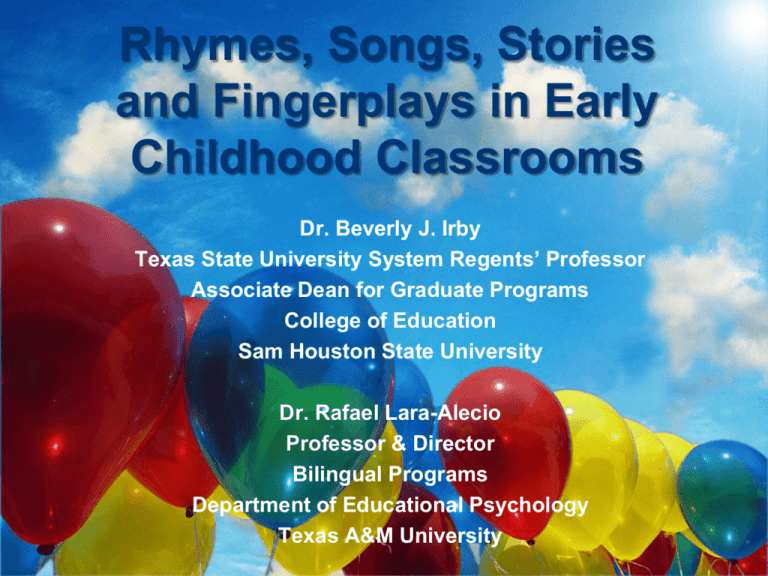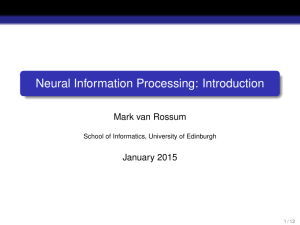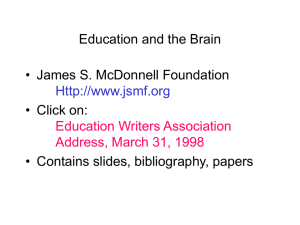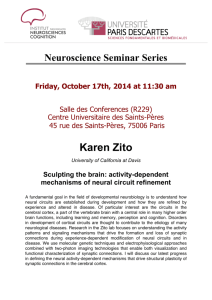Rhymes, Songs, Stories and Fingerplays in Early Childhood
advertisement

Rhymes, Songs, Stories and Fingerplays in Early Childhood Classrooms Dr. Beverly J. Irby Texas State University System Regents’ Professor Associate Dean for Graduate Programs College of Education Sam Houston State University Dr. Rafael Lara-Alecio Professor & Director Bilingual Programs Department of Educational Psychology Texas A&M University What Do We Know About How Children Learn? Basic Brain Information • The brain research that we can currently rely on comes from cognitive psychology which has a well-established 50-year connection to education as opposed to a less than 20-year connection between cognitive psychology and neuroscience. The latter allows us to “see how mental functions map onto the brain structures” (Bruer, 1997, p. 4). Neuroscience and Education • There are three well-established findings in developmental neurobiology: • 1. Starting at infancy and continuing into later childhood, there is a dramatic increase in the number of synapses that connect neurons in the brain. Biology 101 • Neurons have specialized projections called dendrites and axons. Dendrites bring information to the cell body and axons take information away from the cell body. Information from one neuron flows to another neuron across a synapse. The synapse is a small gap separating neurons. Synapse • The synapse consists of: • 1. a presynaptic ending that contains neurotransmitters, mitochondria and other cell organelles, 2. a postsynaptic ending that contains receptor sites for neurotransmitters and, 3. a synaptic cleft or space between the presynaptic and postsynaptic endings. • 2. There are experience-dependent critical periods in the development of sensory and motor systems. • 3. In rats, at least-- complex, or enriched, environments cause new synapses to form (Bruer, 1997, p.4). • Additionally, myelinazation of axons which carry the signals occur at different time periods (Markezich, n.d.) So, what does this mean? • The brain knows how to developmentally scaffold itself. For example, in Broca's area, the region in the brain for language production, it has been determined that when this becomes myelinated, children develop speech and grammar. In Wernicke's area, the center of language comprehension, myelination occurs a good 6 months before Broca's area even starts. This is very clever, since you need to be able to understand language before you can produce it (Zadina, 2006). And what else does this mean? • Starting in early infancy, there is a rapid increase in the number of synapses or neural connections in children’s brains. Up to age 10, children’s brains contain more synapses than at any other time their lives. • Early childhood experiences fine-tune the brain’s synaptic connections (Zadina, 2006). http://www.sesameworkshop.org/sesamestreet/ games/flash.php?contentId=9215277 Synaptic Pruning • Childhood experiences reinforce and maintain synapses that are repeatedly used, but snip away at the unused synapses. • Therefore, the time of high synaptic density and experiential fine-tuning is a critical period in the child’s cognitive development – the time when the brain can efficiently acquire and learn a range of skills (Bruer, 1997, p. 4). During the critical period: • The classroom must be particularly rich and stimulating as this is a critical window of opportunity for brain development. • This natural acquisition period– means that the earlier we teach concepts the better (Hirsch, 1996, p.23); in particular, those concepts should be taught in a meaningful and relevant way (Lara-Alecio & Irby, 2001). So, What does this mean? • The implication is that if information is presented to children in ways that fit each child’s learning style, children are capable of learning more than currently believed (Education Commission of the States, 1996, p. vi.). • Additionally, this urges us to begin the study of languages, advanced mathematics, logic, and music as early as possible– three or four (Bruer, 1997). • http://www.lindabook.com/afrogstalevideo .html • • • • • • • • • • • • Rich, stimulating environments Places for group learning like tables and desks grouped together, to stimulate social skills and cooperative work groups Link indoor and outdoor spaces so students Safe places for students to be where threat is reduced, particularly in large urban settings. Variety of places that provide different lighting, and nooks and crannies Change displays in the classroom regularly to provide a stimulating situations for brain development. Have multiple resources available. Provide educational, physical and a variety of setting within the classroom so that learning activities can be integrated easily. Computers areas, wet areas, experimental science areas should be in close proximity to one another. Multiple functions of learning is our goal. The teachable moment must be recognized and capitalized upon Active and passive places: Students need quiet areas for reflection and retreat from others to use intrapersonal intelligences. Personal space: Students need a home base, a desk, a locker area. All this allows learners to express their unique identity. The community at large as an optimal learning environment: Teachers need to find ways to fully use city space and natural space to use as a primary learning setting. Technology, distance learning, community and business partnerships, all need to be explored by educational institutions. Enrichment: The brain can grow new connections at any age. Challenging, complex experiences with appropriate feedback are best. Cognitive skills develop better with music and motor skills. (Darcangelo, 2000) Morning Circle Time and Research • Morning Circle Time– Builds an atmosphere of trust and intellectual safety. • Some of the brain research has focused less on the physical and biochemical structure of the brain and more on the mind-- a complex mix of thoughts, perceptions, feelings, and reasoning. Studies that explore the effects of attitudes and emotions on learning indicate that stress and constant fear, at any age, can circumvent the brain's normal circuits. A person's physical and emotional well-being are closely linked to the ability to think and to learn effectively. Emotionally stressful home or school environments are counterproductive to students' attempts to learn. • When the teacher speaks directly and personally to the child, synapses fire. The repetition of these kinds of positive early interactions actually helps the brain reinforce the existing connections and make new ones (Honig, 1999). This action on the part of the teacher prevents synapse pruning. Morning Circle Time • In addition to the mental well being that the circle time fosters, this time is usually introduced with a song or a chant. • It is best when the songs and activities are relevant to the child’s life/culture. • By exposing children to complex musical sounds (Mozart, not hard rock) or the simple children’s tunes, children will develop the same areas of the brain required for math and spatial reasoning (DeBord, 1997). Letter Knowledge • Exposure to unfamiliar speech sounds is initially registered by the brain as undifferentiated neural activity. • Neural activity is diffuse, because the brain has not learned the acoustic patterns that distinguish one sound from another. • As exposure continues, the listener (and the brain) learns to differentiate among different sounds and even among short sequences of sounds that correspond to words or parts of words. • Neural connections that reflect this learning process are formed in the auditory (temporal) cortex of the left hemisphere for most individuals. • With further exposure, both the simple and complex circuits (corresponding to simple sounds and sequences of sounds) are activated at virtually the same time and more easily (Genesee, 2000). Neural Networks • As connections are formed among adjacent neurons to form circuits, connections also begin to form with neurons in other regions of the brain that are associated with visual, tactile, and even olfactory information related to the sound of the word. These connections give the sound of the word meaning. • Some of the brain sites for these other neurons are far from the neural circuits that correspond to the component sounds of the words; they include sites in other areas of the left hemisphere and even sites in the right hemisphere. The whole complex of interconnected neurons that are activated by the word is called a neural network (Genesee, 2000). Learning New Letters/Words • The flow of neural activity is not unidirectional, from simple to complex; it also goes from complex to simple. • For example, higher order neural circuits that are activated by contextual information associated with the word doggie can prime the lower order circuit associated with the sound doggie with the result that the word doggie can be retrieved with little direct input. • Complex circuits can be activated at the same time as simple circuits, because the brain is receiving input from multiple external sources: auditory, visual, spatial, motor. • At the same time that the auditory circuit for the word doggie is activated, the visual circuit associated with the sight of a dog is also activated. • Simultaneous activation of circuits in different areas of the brain is called parallel processing. • Students' vocabulary acquisition can be enhanced when it is embedded in realworld complex contexts that are familiar to them. Students need time and experience ("practice") to consolidate new skills and knowledge to become fluent and articulated. Movement and Music • Music seems to involve the brain at almost every level. Even allowing for cultural differences in musical tastes, researchers have found evidence of music's remarkable power to affect neural activity no matter where they look in the brain, from primitive regions in all animals to more recently evolved regions thought to be distinctively human (Los Angeles Times, 1998). Movement • Movement is the only thing that unites all brain levels and integrates the right and left hemispheres of young learners. The locomotion centers of the brain are paired, facing one another along the top of the right and left hemispheres, so that the center controlling the left leg parallels the center controlling the right leg, and so forth. For this reason, movement ties in both hemispheres, allowing young children almost their only opportunity to apply both sides of the brain to an effort and attempt to pass information between the right and left hemispheres. For this reason many young children (and older kinesthetic learners) must move to learn. They are able to pay attention and learn only if they are free to wiggle around; sitting still is a strain. Fingerplay • By a couple of months of age, babies can process the emotional contours of language (prosody), which means they tune in to the emotional variations in your voice. (In fact, toddlers can memorize nursery rhymes because rhymes have prosody!) As the preschool teacher raises his/her voice an octave and draws out his/her vowels, the child's brain responds by sending even more chemical and electrical impulses across the synapses (Honig, 1999). Effective ESL Strategies • The bilingual brain develops more densely, giving it an advantage in various abilities and skills, according to Andrea Mechelli of London's Wellcome Department of Imaging Neuroscience. • The brain has two types of tissue visible to the naked eye, termed gray and white matter. Gray matter makes up the bulk of nerve cells within the brain. Studies have shown an association with gray matter density (or volume and intellect), especially in areas of language, memory, and attention. • Brain imaging showed that bilingual speakers had denser gray matter compared with monolingual participants (Hitti, 2004). Practice/Learning Centers • Children learn best through interaction with their environment and through active participation, a learning center is an optimal way to structure and extend the learning of your students. • Thematic integrative, cooperative, workstations help develop the child’s brain connectivity (Caine & Caine, 1991). Reflect and Assess • Caine and Caine (1991) recommend a learning environment that includes three key factors: immersion in complex experiences, low threat/high challenge, and active processing. • Complex experiences include the range of emotions and levels of thinking that aid in the brain’s learning process. • Environments that present high challenge in the absence of threat promote the brain’s desire to search for meaning and patterns, to make connections. • Finally, active processing refers to metacognition, or how you know what you know. • This means providing time for reflection, verbalizing, and more reflection. Outside/Physical Activity • General physical activity stimulates brain development because it supplies the brain with glucose, its main energy source. However, according to Gabbard at Texas A&M University, [A]t this point it is still quite unclear as to the specific types and amounts of experience necessary to stimulate the formation of particular neural connections (A cautionary note on brain research, 2000). • We do know that physical activity and movement enhance fitness, foster growth and development, and help teach children about their world. Story Time • Reading aloud, sharing music and rhymes have an incredible impact on later learning. • Young children need real interactions in order to learn. • Using melodic voice tones to ensure children's involvement and learning and develops neural networks. Things to Remember • The brain is not rigid at birth, but "plastic" meaning that it has the "ability to change its structure and chemistry in response to the environment." • The environment and genetics are equally important. "The environment affects how genes work and genes determine how the environment is interpreted." • The brain seeks connections. There are critical development periods in which the brain is "wired" for learning a particular skill (not a new idea, but now supported by current brain research). • The brain is superactive between ages 4 and 10, called the "wonder years of learning." Brain research supports early education efforts and parental education efforts. Caine and Caine’s 12 Principles • The brain is a parallel processor in which thoughts, experiences, and emotions operate simultaneously and interact with other modes of information. • Learning engages the entire physiology. Physical health, sleep, nutrition, moods, and fatigue, all affect the brain’s memory. • The search for meaning is innate. The brain needs and automatically registers the familiar while simultaneously searching for and responding to additional stimuli. • The search for meaning occurs through patterning, organizing and categorizing information in meaningful and relevant ways. • Emotions are critical to patterning. Emotion cannot be separated from cognition. Emotion motivates us to learn, to create. 12 Principles cont. • Every brain simultaneously perceives and creates wholes and parts. • Learning involves both focused attention and peripheral perception. Learning happens all the time, everywhere. • Learning involves conscious and unconscious processes. Learners become their experience and remember what they experience not just what they are told. Meaning is not always available on the surface. It often happens intuitively. • The brain uses at least two kinds of memory: spatial memory and rote memory. • The brain understands and remembers but when facts and skills are embedded in natural spatial memory. • Learning is enhanced by challenge and inhibited by threat. • Each brain is unique with individual learning styles and ways of learning. References • “A cautionary note on brain research.” (Fall, 2000). Northwest Education Magazine. Retrieved on October 1, 2005 from http://www.nwrel.org/nwedu/fall_00/caterpillar1.html. • Bruer, J.T. (1997). Education and the brain: A bridge too far. Educational Researcher, 26 (8), 4-16. • Caine, R.N., & Caine, G. (1991). Making connections: Teaching and the human brain. Menlo Park: Addison Wesley. • D'Arcangelo, M. (2000). How does the brain develop? A conversation with Steven Peterson. Educational Leadership, 58(3), 68-71. • DeBord, K. (1997). Brain development. [Extension Publication ]. Raleigh, NC: North Carolina Cooperative Extension Service. (Retrieved on October 2, 2005 from http://www.ces.ncsu.edu/depts/fcs/human/pubs/brain References • Genesee, F. (2000). Brain research: Implications for second language learning. ERIC Digest. ED447727 . • Hirsch, E.D. (1996). The schools we need and why we don’t have them. New York: Doubleday. • Hitti, A. (2004). Being bilingual boosts brain power. WebMD Medical News. (Retrieved on October 5, 2005 from http://my.webmd.com/content/article/95/103242.htm. • • • Honig, A.S. (1999). Scholastic Parent and Child. Los Angeles Times (November 11, 1998). Brain comes alive to sound of music. Zadina, J. (February, 2006). Our plastic brains can be rewired. Paper presented at Sam Houston State University, Huntsville, TX. • Lara-Alecio, R, Bass, J., & Irby, B. J. (2001). Ethnoscience: Considering Mayan culture and astronomy. The Science Teacher, 68(3), 48-51. • Markezich, A. (n.d.) Learning windows and the child’s brain. Superkids. (Retrieved on October 1, 2005 from http://www.superkids.com/aweb/pages/features/early1/early1.shtml).







